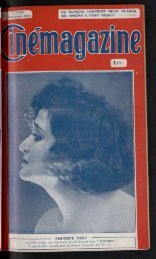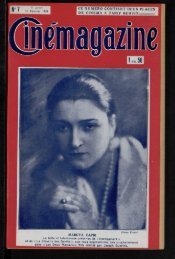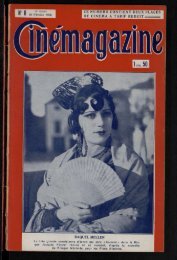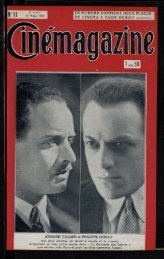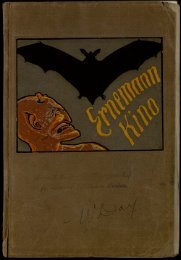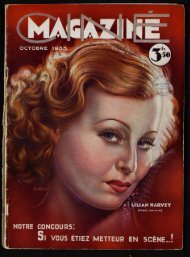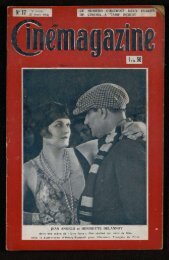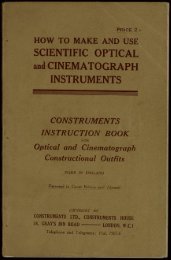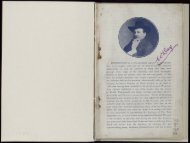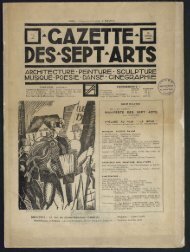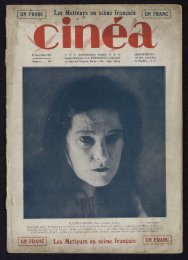Untitled
Untitled
Untitled
You also want an ePaper? Increase the reach of your titles
YUMPU automatically turns print PDFs into web optimized ePapers that Google loves.
84 MODERN MAGIC LANTERNS.<br />
required is the removal of the tubes carrying the objective,<br />
so that objects much thicker than the usual slides can be<br />
inserted, and the provision in consequence of some other<br />
kind of support for the front lens. A method of effecting<br />
this is shown in Fig. 60.<br />
Such a lantern will admit of the insertion of cells of<br />
liquid, test tubes, galvanometers, and many other pieces of<br />
apparatus. The number of scientific experiments which can<br />
be shown in a lantern of this class is legion, but we can only<br />
give as examples one or two that can be performed.<br />
The development and fixation of a photographic plate can<br />
be shown by the use of a tank, as shown in Fig. 61. A<br />
chloride or lantern plate should be employed, both on account<br />
of its superior transparency and of its lower sensitiveness<br />
to light, the developer<br />
being ferrous ox alate.<br />
The plate is exposed under<br />
a negative in the<br />
ordinary way, and is<br />
then placed in the tank,<br />
care being taken that the<br />
image on the plate is upside<br />
down. The plate<br />
should be protected from<br />
actinic light by the insertion<br />
of a piece of ruby<br />
glass between the condenser and the tank before the experiment<br />
commences. When the plate is in position it can be<br />
focussed, a strip of wood being inserted so as to hold the<br />
back of the plate in contact with that glass of the cell which<br />
is furthest from the lantern. Unless the wood is weighted<br />
it will probably float up when the developer is poured in,<br />
and the success of the experiment will be marred. When<br />
the plate is thus held in position and focussed, the developer<br />
must be carefully poured in with the help of a funnel, no<br />
splashing being allowed to take place. When all the plate<br />
is protected by the developer the ruby glass may be removed,<br />
the deep orange tint of the solution being a sufficient<br />
protection with a slow plate. The image will be seen<br />
gradually to grow up on the originally plain opalescent<br />
LANTERN EXPERIMENTS. 85<br />
plate. When development is complete, the ruby glass<br />
should be again inserted, the tank withdrawn and emptied,<br />
the plate rinsed in slightly acidulated water, then in plain<br />
water, and restored to the empty tank replaced in the<br />
lantern. This is now filled with fixing solution, which will<br />
be seen to dissolve gradually the unaltered silver salts in<br />
the film, leaving the finished transparency, if all has gone<br />
well, in full brilliancy on the screen, when the ruby glass<br />
can be finally withdrawn. This experiment is a very<br />
striking one, and is not difficult to perform, but it should be<br />
rehearsed once or twice before being attempted In public, a<br />
remark which applies to all demonstrations of a like nature.<br />
It is often convenient to be able to show upon the screen<br />
the presence of currents of electricity set up by one means<br />
or another ; this is easily done. At any of the shops which<br />
supply working jewellers, such as are to be found in the<br />
neighbourhood of Clerkenwell, little compasses with glass<br />
Fig. 62. LANTERN GALVANOMETER.<br />
sides, which when mounted are often worn on watch<br />
chains, etc., can be purchased for a, few pence. One of<br />
these can be easily made into a fairly sensitive galvanometer<br />
by mounting it in a wooden block, as shown in<br />
Fig. 62. Round the block should be wound some turns of<br />
silk-covered copper wire, B B, Fig. 62; twenty or thirty<br />
turns of No. 30 B W G wire will answer most requirements,<br />
though more can be used if necessary, the two<br />
ends of the wire being brought out to two terminals, D D,<br />
on the end of the block. A little bar magnet, c, which can



